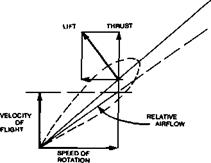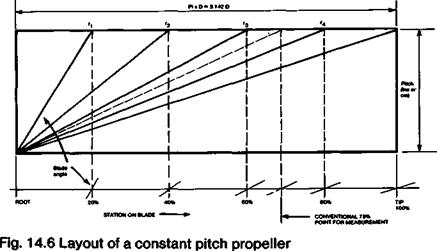BLADE LIFT AND PROPELLER THRUST
|
Figure 14.4 shows how the thrust produced by a propeller blade depends upon the speed ■ of rotation and the velocity of flight. The speed of the blade at any radial point, relative to the air, is a resultant of its speed around the circumference of the circle at its radial distance, and the forward velocity. The relative airflow is thus expressed in both speed and direction by the diagonal line appropriately labelled in the drawing. The angle of attack, measured from the geometric chord, relates to this relative flow line and is obviously less than the pitch.
|
|
Fig. 14.5 Angle of attack and thrust near the propeller hub.
|
So long as the angle of attack is greater than the aerodynamic zero of the section, lift will be produced but at right angles to the airflow, not to the propeller disc. The lift vector is thus inclined backwards relative to the plane of rotation. Resolution of the lift force demonstrates that the effective thrust is less than the lift and there is a component which must be added to the total blade drag.
At any radial station closer to the hub of the propeller than this, although the forward velocity must be the same, the speed of rotation is less. The relative speed and direction of the airflow at such a point is represented in Figure 14.5. To keep the blade here at the same angle of attack to the air, its angle to the disc plane must be increased. The effect of this is to tilt the lift vector considerably more against the rotation so that a large proportion of the force is available for thrust and more goes to resisting the rotation.
Since the relative flow speed is less than further out on the blade, the absolute magnitude of the lift force is less in any case, if the blade chord is similar.
For these reasons, the inner segments of a propeller are considerably less efficient as producers of thrust than the outer parts. Close to the hub the relative flow is almost directly along the axis of rotation and no thrust comes from this part of the blade at all. In practice, about 20% of each blade, measuring from the drive shaft outwards, may be neglected and, for the sake of all-round drag reduction, may be faired by a spinner with very little, if any, sacrifice of thrust.













